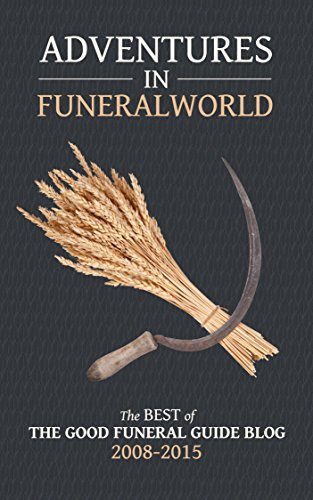Finally, we can reveal the successful contenders who have made The Long List for the 2016 Good Funeral Awards
This year we have received more nominations than ever before, and with 24 categories, there are over 170 individuals or companies who will be considered for a chance to win one of the most covetable accolades in Funeralworld.
We don’t envy the judges their task this time around; the standard of entries is extraordinarily high, and the supporting testimonials that have been pouring in are heartfelt and often deeply grateful – many hundreds of people have taken the time to write in to tell us about the kindness, the skill or the care they received from their nominee when they were bereaved, and how much this meant to them.
Every letter or e-mail received in support of those named on the Long List will be handed over next week for the final decision making by the Good Funeral Awards judges, those eminences whose identities remain a closely guarded secret.
Their final choices of the winning entrants will be revealed at the glittering lunchtime Awards Ceremony on September 8th, which is being hosted by comedian and author Shappi Khorsandi at London’s grand Porchester Hall – an event made possible by the generosity of our main sponsor Funeralbooker, a donation from our good friends at Greenfield Creations and the support of our individual category sponsors (shown below).
Everyone is welcome to come along, whether or not you were nominated, or are on the 2016 Long List. The Good Funeral Awards are a day to celebrate the changing world of funerals and the wonderful people that inhabit it. And this year it’s going to be a very stylish occasion. Wear your best frocks. There will be cameras and journalists a-plenty; a London awards ceremony for the funeral industry is intriguing the media!
If you haven’t already booked your place at the best party in town, click here to order your ticket for the Awards Lunch, or e-mail us for an invoice.
And if you have made it to the 2016 Good Funeral Awards Long List, congratulations. Really, really well done. You should be immensely proud to see your name below.
The 2016 Good Funeral Awards Long List
1. Minister of the Year
Revd. Canon Gill Behenna (Chaplain among Deaf people in the Diocese of Bristol)
Revd. Kate Bottley (Vicar of the churches of Blyth, Scrooby and Ranskill and Chaplain to North Notts College)
Revd. Richard Mitchell (formerly of the Parish Church of St. Paul, Shurdington, now Canon Precentor at Gloucester Cathedral)
Revd. Melanie Toogood (Former Vicar of St. George & All Saints, Tufnell Park)
2. Celebrant of the Year (sponsored by Civil Ceremonies Ltd.)
John Banks
Diana Gould
Angela (Basira) Ward
3. Embalmer of the Year
Andy Holder
4. Coffin Supplier of the Year (sponsored by ECoffins)
5. Florist of the Year
6. Gravedigger of the Year
Ivor Davies (Caerphilly County Borough Council)
Martin House (Eden Valley Woodland Burial Ground)
Will Pearce
D. T. H. Burial & Churchyard Service
7. Cemetery of the Year
Eden Valley Woodland Burial Ground
Greenacres Woodland Burials Chiltern
Gardens of Peace Muslim Cemetery
8. Crematorium of the Year (sponsored by Scattering Ashes)
Thornhill Crematorium, Cardiff
9. Best Internet Bereavement Resource
10. Best Funeral Caterer
Tamworth Co-operative Funeral Service
11. Best Alternative to a Hearse
Harrison Funeral Home Electric Vehicle
12. Best Green Funeral Product
13. Most Significant Contribution to the Understanding of Death (sponsored by Final Fling)
Tamworth Co-operative Funeral Service
The Natural Death Centre Charity
14. Best Maker of Hand Carved Memorials in an Indigenous Material
The Cardozo Kindersley Workshop
15. Low Cost Funeral Provider of the Year
Express-Burials & Express Cremations
Wallace Stuart Funeral Directors
16. Green Funeral Director of the Year (sponsored by The Association of Green Funeral Directors)
17. Funeral Arranger of the Year
Angela Bailey at Harrison Funeral Home
Emma Fisher at Colin Fisher Funeral Directors
Sarah Lee of Holmes & Family Funeral Directors
Sarah Wolsey at Daniel Ross Funerals Ltd.
18. Most Promising New Funeral Director (sponsored by The Church of England)
Chloe Middleton (Rosedale Funeral Home)
C. S. Boswell Independent Family Funeral Services
Final Journey Funeral Directors
Youngs Independent Funeral Services
19. Modern Funeral Director of the Year (sponsored by The Natural Death Centre Charity)
Respect Direct Funeral Services
Tamworth Co-operative Funeral Service
The Individual Funeral Company
Town & Country Funeral Directors
Wallace Stuart Funeral Directors
20. Traditional Funeral Director of the Year (sponsored by A. R. Adams Funeral Directors)
David Crayton of John Lucas Funerals
Suzan Davies of Abbey Funeral Services
Oliver Holmes of Holmes & Family Funeral Directors
Tamworth Co-operative Funeral Service
The Individual Funeral Company
Wallace Stuart Funeral Directors
21. Most Innovative Death Public Engagement Event
22. Mortuary Assistant or Team of the Year (including Anatomical Pathology Technicians)
Wayne Day at T. E. W. Hickson Ltd.
Lara-Rose Iredale at Guys & St. Thomas NHS Foundation Trust
Louise Milligan at Stockport NHS Foundation Trust
Hannah Nutbeem at Heart & Soul Funeral Directors
The team at The John Radcliffe Hospital
23. Crematorium Assistant of the Year
Steve Biggs at Mortlake Crematorium
Roy Paget at Solihull Bereavement Services
Gary Paterson at Breakspear Crematorium
Paul Rayner at Solihull Bereavement Services
Carolyne Reeve at Teesside Crematorium
The entire team at Golders Green Crematorium
The entire team at Redditch Crematorium
24. Lifetime Achievement Award
Nicholas Albery (posthumously)


